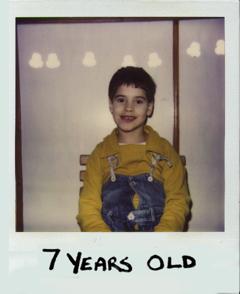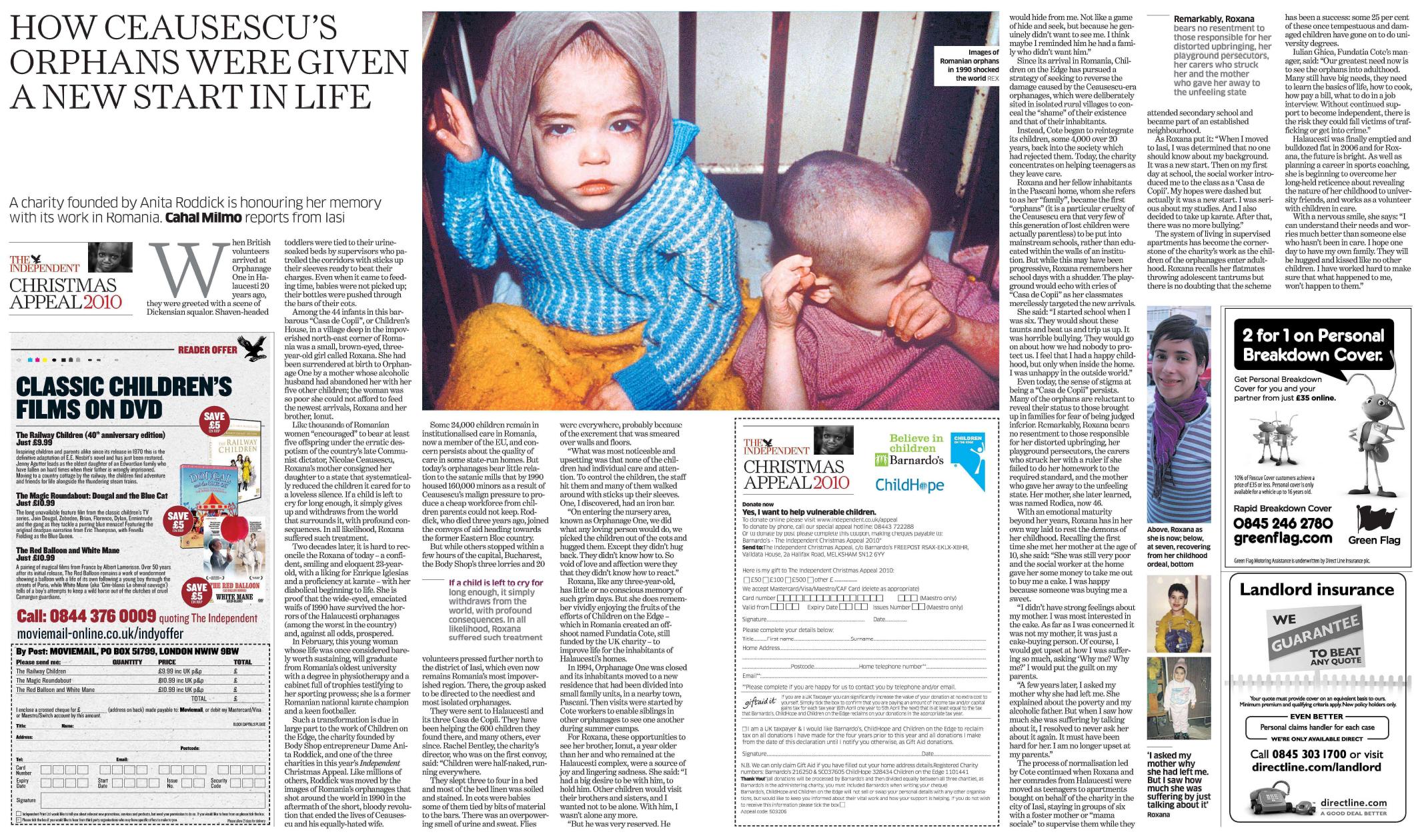How Ceausescu’s lost souls were given a new start in life
In 2010, a charity founded by Anita Roddick honoured her memory with its work in Romania. Cahal Milmo reported from Iasi

When British volunteers arrived at Orphanage One in Halaucesti 20 years ago, they were greeted with a scene of Dickensian squalor. Shaven-headed toddlers were tied to their urine-soaked beds by supervisors who patrolled the corridors with sticks up their sleeves ready to beat their charges. Even when it came to feeding time, babies were not picked up; their bottles were pushed through the bars of their cots.
Among the 44 infants in this barbarous “Casa de Copii”, or Children’s House, in a village deep in the impoverished northeast corner of Romania was a small, brown-eyed, three-year-old girl called Roxana. She had been surrendered at birth to Orphanage One by a mother whose alcoholic husband had abandoned her with her five other children; the woman was so poor she could not afford to feed the newest arrivals, Roxana and her brother, Ionut.
Like thousands of Romanian women “encouraged” to bear at least five offspring under the erratic despotism of the country’s late Communist dictator, Nicolae Ceausescu, Roxana’s mother consigned her daughter to a state that systematically reduced the children it cared for to a loveless silence.
If a child is left to cry for long enough, it simply gives up and withdraws from the world that surrounds it, with profound consequences. In all likelihood, Roxana suffered such treatment.v
Two decades later, it is hard to reconcile the Roxana of today – a confident, smiling and eloquent 23-year-old, with a liking for Enrique Iglesias and a proficiency at karate – with her diabolical beginning to life. She is proof that the wide-eyed, emaciated waifs of 1990 have survived the horrors of the Halaucesti orphanages (among the worst in the country) and, against all odds, prospered.
The secret suffering of Ceausescu’s babies: read the report that sparked a 20-year story
In February, this young woman whose life was once considered barely worth sustaining, will graduate from Romania’s oldest university with a degree in physiotherapy and a cabinet full of trophies testifying to her sporting prowess; she is a former Romanian national karate champion and a keen footballer.
Such a transformation is due in large part to the work of Children on the Edge, the charity founded by Body Shop entrepreneur Dame Anita Roddick, and one of the three charities in this year’s Independent Christmas Appeal. Like millions of others, Roddick was moved by the images of Romania’s orphanages that shot around the world in 1990 in the aftermath of the short, bloody revolution that ended the lives of Ceausescu and his equally-hated wife. Some 24,000 children remain in institutionalised care in Romania, now a member of the EU, and concern persists about the quality of care in some state-run homes.
But today’s orphanages bear little relation to the satanic mills that by 1990 housed 160,000 minors as a result of Ceausescu’s malign pressure to produce a cheap workforce from children parents could not keep. Roddick, who died three years ago, joined the convoys of aid heading towards the former Eastern Bloc country.

But while others stopped within a few hours of the capital, Bucharest, the Body Shop’s three lorries and 20 volunteers pressed further north to the district of Iasi, which even now remains Romania’s most impoverished region. There, the group asked to be directed to the neediest and most isolated orphanages.
They were sent to Halaucesti and its three Casa de Copii. They have been helping the 600 children they found there, and many others, ever since. Rachel Bentley, the charity’s director, who was on the first convoy, said: “Children were half-naked, running everywhere.
“They slept three to four in a bed and most of the bed linen was soiled and stained. In cots were babies some of them tied by bits of material to the bars. There was an overpowering smell of urine and sweat. Flies were everywhere, probably because of the excrement that was smeared over walls and floors.
“What was most noticeable and upsetting was that none of the children had individual care and attention. To control the children, the staff hit them and many of them walked around with sticks up their sleeves. One, I discovered, had an iron bar.
To control the children, the staff hit them and many of them walked around with sticks up their sleeves. One, I discovered, had an iron bar
“On entering the nursery area, known as Orphanage One, we did what any loving person would do, we picked the children out of the cots and hugged them. Except they didn’t hug back. They didn’t know how to. So void of love and affection were they that they didn’t know how to react.”
Roxana, like any three-year-old, has little or no conscious memory of such grim days. But she does remember vividly enjoying the fruits of the efforts of Children on the Edge – which in Romania created an offshoot named Fundatia Cote, still funded by the UK charity – to improve life for the inhabitants of Halaucesti’s homes.
In 1994, Orphanage One was closed and its inhabitants moved to a new residence that had been divided into small family units, in a nearby town, Pascani. Then visits were started by Cote workers to enable siblings in other orphanages to see one another during summer camps.
For Roxana, these opportunities to see her brother, Ionut, a year older than her and who remained at the Halaucesti complex, were a source of joy and lingering sadness. She said: “I had a big desire to be with him, to hold him. Other children would visit their brothers and sisters, and I wanted not to be alone. With him, I wasn’t alone any more.

“But he was very reserved. He would hide from me. Not like a game of hide and seek, but because he genuinely didn’t want to see me. I think maybe I reminded him he had a family who didn’t want him.”
Since its arrival in Romania, Children on the Edge has pursued a strategy of seeking to reverse the damage caused by the Ceausescu-era orphanages, which were deliberately sited in isolated rural villages to conceal the “shame” of their existence and that of their inhabitants.
Many still have big needs, they need to learn the basics of life, how to cook, how to pay a bill, what to do in a job interview. Without continued support to become independent, there is the risk they could fall victims of trafficking or get into crime
Instead, Cote began to reintegrate its children, some 4,000 over 20 years, back into the society which had rejected them. Today, the charity concentrates on helping teenagers as they leave care.
Roxana and her fellow inhabitants in the Pascani home, whom she refers to as her “family”, became the first “orphans” (it is a particular cruelty of the Ceausescu era that very few of this generation of lost children were actually parentless) to be put into mainstream schools, rather than educated within the walls of an institution.
But while this may have been progressive, Roxana remembers her school days with a shudder. The playground would echo with cries of “Casa de Copii” as her classmates mercilessly targeted the new arrivals. She said: “I started school when I was six. They would shout these taunts and beat us and trip us up. It was horrible bullying. They would go on about how we had nobody to protect us. I feel that I had a happy childhood, but only when inside the home. I was unhappy in the outside world.”
Even today, the sense of stigma at being a “Casa de Copii” persists. Many of the orphans are reluctant to reveal their status to those brought up in families for fear of being judged inferior. Remarkably, Roxana bears no resentment to those responsible for her distorted upbringing, her playground persecutors, the carers who struck her with a ruler if she failed to do her homework to the required standard, and the mother who gave her away to the unfeeling state. Her mother, she later learned, was named Rodica, now 46.
25%
of Children on the Edge orphans went to university
With an emotional maturity beyond her years, Roxana has in her own way laid to rest the demons of her childhood. Recalling the first time she met her mother at the age of 10, she said: “She was still very poor and the social worker at the home gave her some money to take me out to buy me a cake. I was happy because someone was buying me a sweet.
“I didn’t have strong feelings about my mother. I was most interested in the cake. As far as I was concerned it was not my mother, it was just a cake-buying person. Of course, I would get upset at how I was suffering so much, asking ‘Why me? Why me?’ I would put the guilt on my parents.
“A few years later, I asked my mother why she had left me. She explained about the poverty and my alcoholic father. But when I saw how much she was suffering by talking about it, I resolved to never ask her about it again. It must have been hard for her. I am no longer upset at my parents.”

The process of normalisation led by Cote continued when Roxana and her comrades from Halaucesti were moved as teenagers to apartments bought on behalf of the charity in the city of Iasi, staying in groups of six with a foster mother or “mama sociale” to supervise them while they attended secondary school and became part of an established neighbourhood.
As Roxana put it: “When I moved to Iasi, I was determined that no one should know about my background. It was a new start. Then on my first day at school, the social worker introduced me to the class as a ‘Casa de Copii’. My hopes were dashed but actually it was a new start. I was serious about my studies. And I also decided to take up karate. After that, there was no more bullying.”
The system of living in supervised apartments has become the cornerstone of the charity’s work as the children of the orphanages enter adulthood.
Roxana recalls her flatmates throwing adolescent tantrums but there is no doubting that the scheme has been a success: some 25 per cent of these once tempestuous and damaged children have gone on to do university degrees.
Iulian Ghica, Fundatia Cote’s manager, said: “Our greatest need now is to see the orphans into adulthood. Many still have big needs, they need to learn the basics of life, how to cook, how to pay a bill, what to do in a job interview. Without continued support to become independent, there is the risk they could fall victims of trafficking or get into crime.”
Halaucesti was finally emptied and bulldozed flat in 2006 and for Roxana, the future is bright.
As well as planning a career in sports coaching, she is beginning to overcome her long-held reticence about revealing the nature of her childhood to university friends, and works as a volunteer with children in care. With a nervous smile, she says: “I can understand their needs and worries much better than someone else who hasn’t been in care. I hope one day to have my own family.
“They will be hugged and kissed like no other children. I have worked hard to make sure that what happened to me, won’t happen to them.”
This article first appeared in The Independent on 11 December 2010
Join our commenting forum
Join thought-provoking conversations, follow other Independent readers and see their replies
0Comments